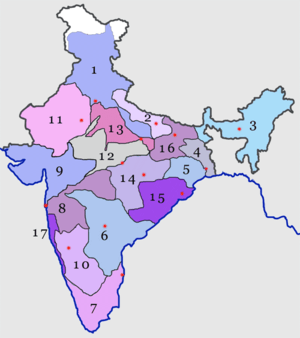North Eastern Railway zone
 2-North Eastern Railway | |
| Dates of operation | 1952–present |
|---|---|
| Predecessor |
Oudh and Tirhut Railway Assam Railway Cawnpore-Barabanki Railway Cawnpore-Achnera Provincial State Railway |
| Successor |
North Eastern Railway zone Northeast Frontier Railway (1958) |
| Track gauge | Mixed |
| Headquarters | Gorakhpur |
| Website | North Eastern Railway |
The North Eastern Railway (abbreviated NER and पूर्वोत्तर रेलवे) is one of the 16 railway zones in India. It is headquartered at Gorakhpur and comprises Lucknow, Varanasi and Izzatnagar or Bareilly division.
History

The North Eastern Railway was formed on 14 April 1952 by combining two Railway systems the Oudh and Tirhut Railway and Assam Railway and the Cawnpore-Achnera Provincial State Railway of the Bombay, Baroda and Central India Railway. The Cawnpore-Barabanki Railway was transferred to the North Eastern Railway on 27 February 1953. NER was bifurcated into two Railway Zones on 15 January 1958, the North Eastern Railway and the Northeast Frontier Railway and all lines east of Katihar were transferred to Northeast Frontier Railway.[1]
By December 2017, railways for the first time installed 6,095 GPS-enabled "Fog Pilot Assistance System" railway signalling devices in four most affected zones, Northern Railway zone, North Central Railway zone, North Eastern Railway zone and North Western Railway zone, by doing away with the old practice of putting firecrackers on train tracks to alter train divers running trains on snail's pace. With these devices, train pilots precisely know in advance, about the location of signals, level-crossing gates and other such approaching markers.[2]
Area covered
Bareily to gorakhpur along the Nepal border. In south up to varanasi and Ayodhya.
Re-organisation
On 1 October 2002, Samastipur and Sonpur Divisions were transferred to East Central Railway. The present N. E. Railway (NER), after re-organisation of Railway Zones in 2002, comprises three Divisions - Varanasi, Lucknow & Izatnagar. NER has 3,402.46 route km with 486 stations. NER primarily serves the areas of Uttar Pradesh, Uttarakhand & western districts of Bihar.
Administration
The administrative head of the zone is called General Manager. The current head of this zone is Mr. Rajiv Agrawal, IRSEE 1980.[3]
Cultural importance
North Eastern Railway passes through/connects to many important tourist and cultural centres like Varanasi, Sarnath, Lucknow, Allahabad, Kushinagar, Lumbani, Ballia, Ayodhaya, Nainital, Ranikhet, Kausani and Dudhwa and maha rajganj
See also
References
- ↑ Rao, M.A. (1988). Indian Railways, New Delhi: National Book Trust, pp.42-4
- ↑ Indian Railways to use GPS-enabled devices to fight fog this season, Economic Times, 12 Dec 2017.
- ↑ "Archived copy". Archived from the original on 24 December 2017. Retrieved 23 December 2017.